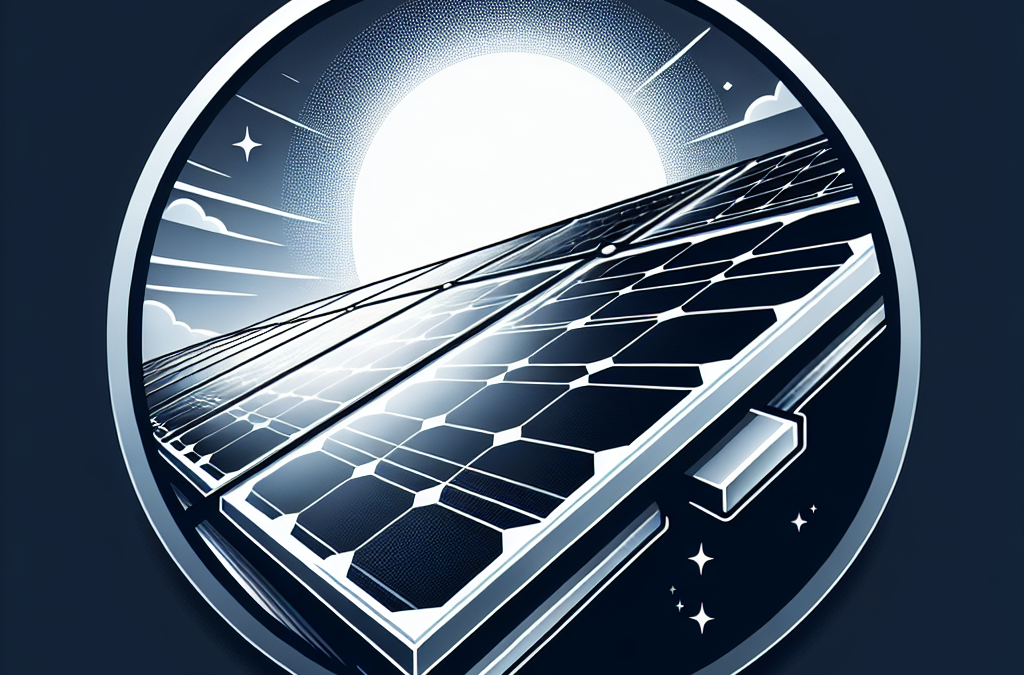So you’re curious about the efficiency of modern solar panels, huh? Well, let me give you the lowdown. In today’s world where sustainable energy is becoming increasingly important, solar panels have taken center stage as a viable solution. But just how efficient are these modern marvels? Well, let me break it down for you. Modern solar panels typically have an efficiency rating ranging from 15% to 20%. That may not sound super impressive at first, but trust me, it’s a big deal. In this article, we’ll take a closer look at what these efficiency ratings mean, why they matter, and how advancements are constantly being made to make solar panels even more efficient. So buckle up, my friend, and let’s explore the exciting world of solar panel efficiency together!
Solar Panel Efficiency Explained
Solar panel efficiency refers to the amount of sunlight that can be converted into usable electricity. In other words, it measures how effectively a solar panel can convert sunlight into electrical energy. This is an important factor to consider when evaluating the performance and effectiveness of solar panels.
Definition of Solar Panel Efficiency
Solar panel efficiency is typically expressed as a percentage and represents the ratio of the amount of electricity produced by a solar panel to the amount of sunlight it receives. In simpler terms, it measures how much of the sunlight hitting a solar panel is actually converted into usable electricity.
Measuring Solar Panel Efficiency
Solar panel efficiency can be measured using a variety of methods. One common way to measure efficiency is by using Standard Test Conditions (STC), which are a set of reference conditions that include a solar irradiance of 1000 watts per square meter and a temperature of 25 degrees Celsius. Another method is the Power Output Ratio (POR), which compares the actual power output of a solar panel to its rated power output under certain conditions.
Factors Affecting Solar Panel Efficiency
Several factors can affect the efficiency of solar panels. One of the primary factors is the quality and type of materials used in the manufacturing process. Higher-quality materials tend to have better light-absorption capabilities, resulting in higher efficiency. The design and construction of the solar panel also play a significant role in its efficiency. Additionally, environmental conditions such as temperature, shading, and dirt accumulation can impact the performance of solar panels.
Types of Solar Panels
There are several different types of solar panels available, each with varying levels of efficiency. The most common types include monocrystalline, polycrystalline, and thin-film solar panels.
Monocrystalline Solar Panels
Monocrystalline solar panels are made from a single crystal structure, typically silicon. Due to their uniform construction, they are known for their high efficiency. Monocrystalline panels have a distinct dark appearance and are often considered the most efficient type of solar panels available. However, they are also the most expensive.
Polycrystalline Solar Panels
Polycrystalline solar panels are made up of multiple crystals and are less expensive to produce than monocrystalline panels. While they may have slightly lower efficiency levels compared to monocrystalline panels, advancements in technology have made them a popular choice for residential and commercial installations.
Thin-Film Solar Panels
Thin-film solar panels are made by depositing a thin layer of photovoltaic material onto a substrate, such as glass or metal. They are typically more flexible and lighter than other types of solar panels, making them ideal for specific applications. However, thin-film panels have lower efficiency levels compared to monocrystalline and polycrystalline panels.
Advancements in Solar Panel Technology
Advancements in solar panel technology have led to the development of more efficient solar panels. These advancements aim to increase the amount of sunlight that can be converted into electricity, thereby improving overall energy production.
High-Efficiency Solar Cells
High-efficiency solar cells are designed to maximize the capture and conversion of sunlight into electricity. These cells use advanced materials, such as perovskites or multi-junction designs, to increase efficiency levels. High-efficiency solar cells are still in the research and development stage but hold great potential for significantly improving solar panel efficiency.
Multi-Junction Solar Cells
Multi-junction solar cells are constructed using multiple layers of photovoltaic materials stacked on top of each other. Each layer absorbs a specific range of sunlight, allowing for more efficient conversion. These cells are commonly used in space applications where high efficiency is crucial due to limited space and high costs.
Passivated Emitter Rear Contact (PERC) Technology
PERC technology involves adding a rear surface passivation layer to solar cells, improving their overall efficiency. This layer reduces the recombination of charge carriers, which leads to higher conversion rates. PERC technology has become increasingly popular in recent years and is now used in many commercially available solar panels.
Improving Conversion Efficiency
To further enhance the efficiency of solar panels, various techniques and technologies can be employed.
Anti-Reflective Coatings
Anti-reflective coatings are applied to the front surface of solar panels to minimize the reflection of sunlight. By reducing the amount of reflected light, more sunlight can be absorbed and converted into electricity, resulting in increased efficiency.
Back Surface Reflector (BSR)
A back surface reflector is a layer placed on the rear surface of a solar cell, which reflects the sunlight that has passed through the cell back into the active region. This allows for additional absorption and increased efficiency.
Tandem Solar Cells
Tandem solar cells combine multiple layers of different materials with varying bandgaps to capture a broader range of the solar spectrum. By utilizing multiple layers, each tuned to a specific wavelength, tandem solar cells can achieve higher efficiencies.
Environmental Factors Impacting Efficiency
The efficiency of solar panels can be influenced by various environmental factors that affect the amount of sunlight reaching the panels and the operating conditions.
Temperature
Solar panels can experience a decrease in efficiency as the temperature increases. This is due to the nature of photovoltaic materials, which are known to have reduced performance as they heat up. It is important to consider the impact of temperature when installing solar panels, as excessive heat can significantly affect their overall efficiency.
Shading
Shading, whether from trees, nearby buildings, or other obstructions, can have a considerable negative impact on the efficiency of solar panels. Even partial shading can result in decreased energy production, as shaded cells are unable to contribute their full potential. Proper positioning and careful consideration of potential shading sources are key when installing solar panels.
Dirt and Dust
The accumulation of dirt and dust on solar panels can also reduce their efficiency. A layer of debris on the surface of the panels can block sunlight and hinder the absorption of light. Regular cleaning and maintenance are necessary to ensure optimal efficiency and maximize energy production.
Efficiency Comparison Across Solar Panel Manufacturers
When considering solar panels, it is important to evaluate the efficiency offered by different manufacturers. Tier 1 solar panel manufacturers are known for producing high-quality panels with consistent performance and efficiency.
Tier 1 Solar Panel Manufacturers
Tier 1 solar panel manufacturers are recognized for their financial stability, long-term warranties, and global market presence. These manufacturers typically have a proven track record of delivering reliable and efficient solar panels. Examples of tier 1 manufacturers include SunPower, LG Solar, and Canadian Solar.
Top Efficient Solar Panels
Several solar panel models stand out for their high efficiency ratings. These panels have achieved impressive conversion rates, allowing for increased energy production from the same amount of sunlight. Examples of top efficient solar panels include the SunPower Maxeon series, LG NeON series, and Panasonic HIT series.
Real-World Efficiency vs. Laboratory Efficiency
It is important to understand the difference between the efficiency stated by manufacturers and the efficiency that can be achieved in real-world conditions.
Standard Test Conditions
Manufacturers typically provide efficiency ratings based on laboratory testing under Standard Test Conditions (STC). These conditions are carefully controlled and represent optimum performance conditions. However, it is important to note that real-world conditions may vary significantly from the STC, which can impact the actual efficiency of solar panels.
Effects of Real-World Conditions
Real-world conditions such as temperature variations, shading from nearby objects, and dirt accumulation can all impact the efficiency of solar panels. Therefore, the efficiency stated by manufacturers may not always be achievable in practical applications. It is essential to consider these factors when evaluating the performance and efficiency of solar panels.
The Role of Efficiency in the Cost of Solar Panels
The efficiency of solar panels can have a direct impact on their cost and potential return on investment.
Cost per Watt
Solar panels with higher efficiency tend to have a higher cost per watt. This is due to the use of advanced materials and manufacturing processes required to achieve greater efficiency. While these higher efficiency panels may have a higher upfront cost, they can result in greater long-term energy savings.
Return on Investment
The efficiency of solar panels also affects the return on investment (ROI) for a solar installation. Higher efficiency panels can produce more electricity for the same amount of sunlight, resulting in greater energy savings over time. This improved energy production can contribute to a faster payback period and increased financial benefits.
Future Prospects for Solar Panel Efficiency
The future of solar panel efficiency holds great potential for further advancements. As technology continues to evolve, new approaches and materials are being explored to achieve even higher efficiency levels.
Perovskite Solar Cells
Perovskite solar cells are a promising area of research, offering the potential for highly efficient and low-cost solar panels. These cells use a unique type of crystal structure that allows for increased absorption of sunlight, leading to higher conversion rates.
Solar Panel Efficiency Records
Efficiency records for solar panels continue to be broken as new technology emerges. Researchers and manufacturers strive to push the boundaries of efficiency, aiming to maximize energy production from solar panels. These records serve as benchmarks for the industry and inspire further innovation.
Potential Breakthroughs
Several potential breakthroughs in solar panel efficiency are being explored. These include advancements in nanotechnology, the use of quantum dots, and improved light-trapping techniques. These breakthroughs have the potential to significantly enhance solar panel efficiency and pave the way for greater adoption of solar energy.
Factors to Consider When Choosing Solar Panels
When choosing solar panels, several factors need to be considered to ensure the best fit for your needs.
Efficiency
Efficiency should be a top consideration when selecting solar panels. Higher efficiency panels can generate more electricity from the same amount of sunlight, maximizing energy production and potential savings.
Cost
The cost of solar panels is another important factor to consider. It is important to strike a balance between efficiency and cost to ensure the best return on investment. Comparing the cost per watt and overall system cost can help determine the most cost-effective option.
Available Space
The available space for installing solar panels is a crucial factor to consider. Different types of solar panels have varying space requirements, and certain panels may be more suitable for limited or unconventional installation spaces. It is important to assess available space and select panels that can be effectively installed.
In conclusion, solar panel efficiency plays a significant role in determining the performance, cost, and potential return on investment of solar panels. Factors such as the type of solar panel, advancements in technology, environmental conditions, and the chosen manufacturer can all impact efficiency. When choosing solar panels, it is important to consider efficiency, cost, and available space to ensure the best fit for your specific needs. As technology continues to advance, the future of solar panel efficiency holds great promise, offering the potential for even greater energy production and widespread adoption of solar energy.









